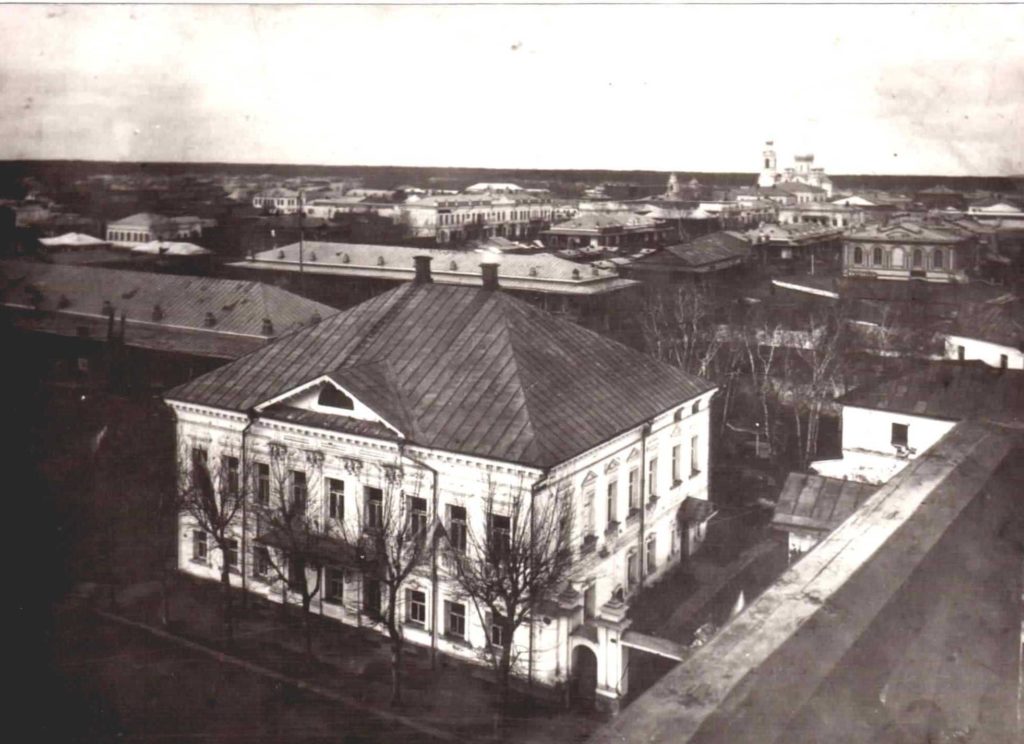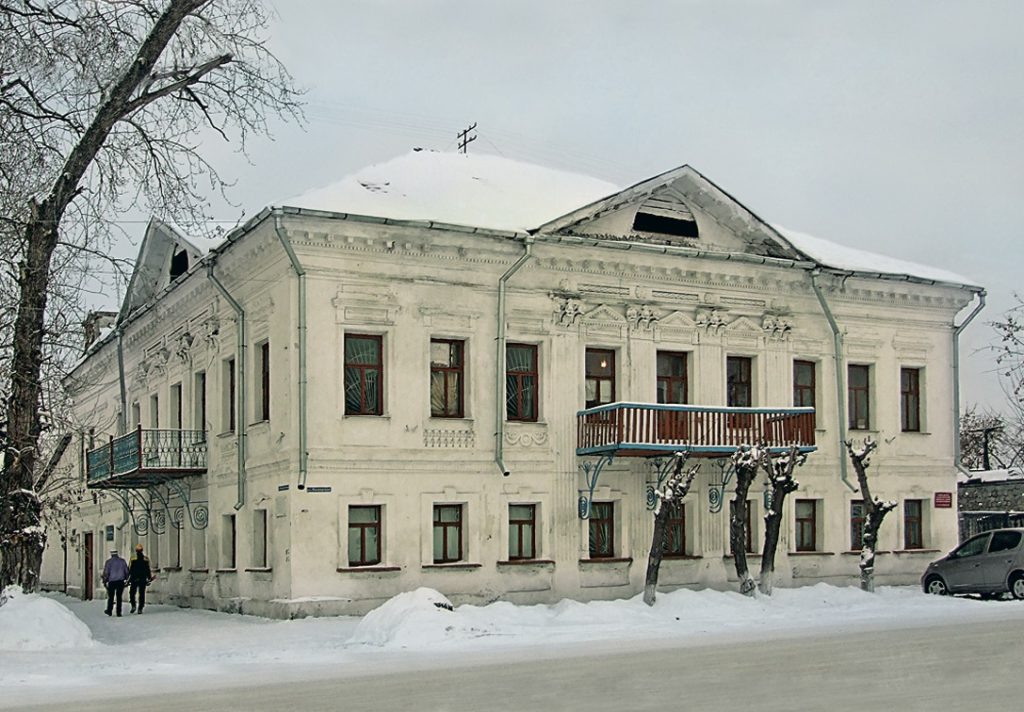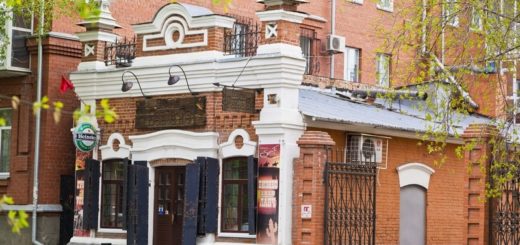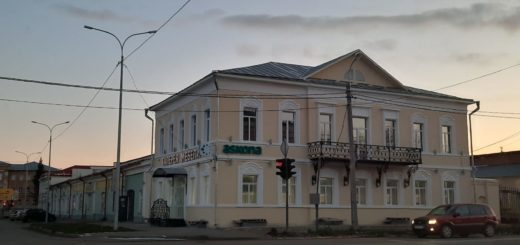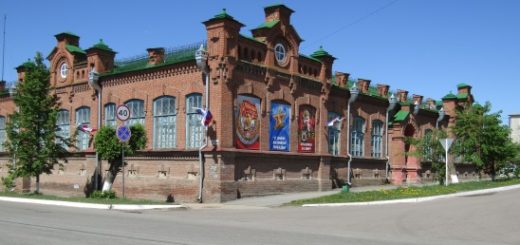Дом жилой Л. Фетисова.
Историческая справка
Объект культурного наследия регионального значения
г. Шадринск, ул. Пионерская,27
Годы постройки-1801-1802
Каменный двухэтажный дом — образец особнякового типа, занимающий угловое положение. Композиция и декор выполнены на уровне профессиональной архитектуры. В убранстве фасада использованы ордерные элементы. Простенки между окон занимают пилястры с капителями коринфского ордера, базами и коннелюрами. Карниз с сухариками представлен в виде антаблемента. Обрамление окон первого этажа отличается лепным венком на замковом камне. Наличники окон второго этажа в виде сандриков с прямоугольными и треугольными фронтонами. На уличных фасадах имеются балконы на кованых металлических консолях в виде волют. Крыша четырехскатная, но над балконами устроены треугольные фронтоны с крупным полуциркульным окном, поэтому центральная часть фасада воспринимается как портик. Все детали, кроме барочного фронтона, заимствованы из стилистики классицизма.
К верхушке шадринского купечества того времени относится большое семейство Фетисовых. Игнатий Гаврилович Фетисов (с 1792 г. второй гильдии купец, с 1807 г. первой гильдии купец) крупный оптовый торговец, вел и заграничную торговлю. Фетисовы постоянно увеличивали своё недвижимое имущество. В 1792 — 94 годах Игнатий Гаврилович Фетисов имел в городе дом и деревянные лавки для торговли. Соответственно своим доходам он в 1801-06 годах построил усадьбу, повторяющую особенности жилого ансамбля городов центральной России XVIII века. Дом являлся частью усадьбы и значился, как первый каменный дом на плане города 1807 года.
В ансамбль усадьбы, кроме жилого дома, входил флигель с жильем наверху и подсобными помещениями внизу. Во дворе усадьбы находилась салотопня, к которой примыкал домик с колоннами, непосредственно переходивший в торговые ряды. Домик с колоннами и торговые ряды выходили на Михайловскую площадь, на которой была развернута основная торговля города. На каменной ограде и воротах, примыкавших к дому со стороны ул. Преображенской (Пионерской), размещались скульптуры львов. Под этой усадьбой земли числилось 805 саженей.
Затем начинается неблагоприятный период, связанный с Отечественной войной 1812 г. и последовавшим за ним застоем. После смерти Игнатия Фетисова в 1820 г. всё хозяйство переходит к старшему сыну Федору, который вкладывает капитал в недвижимость. В течение четырех лет он покупает еще 6 домов в городе, а в 1822 году строит на западной окраине города завод и первым на Урале выпускает фарфоровую и фаянсовую продукцию. Выпускаемая на их фабрике посуда, на мануфактурной выставке в Санкт-Петербурге в 1829 г. признана «добротною, а отделкой посредственною». Посуда украшалась вдавленным или писаным орнаментом. В Шадринском краеведческом музее имеется образец посуды фабрики Фетисовых — блюдо с фестончатым краем борта, без росписи, тиснение в виде марки «Фетисовых».
В 1826 г. рискованные дела с незаконной торговлей золотом (объемы составляли несколько пудов) приводят к аресту его имущества. Это обстоятельство сильно повлияло на размер недвижимости Федора. Купец говорил: «Покупая и продавая золото, не знал вовсе, что торговля золотом запрещена». Лишь к 1834 г. положение семьи поправилось и первыми Почетными гражданами г. Шадринска в этот год стали купцы 1-ой гильдии Фетисовы.
Постепенно род Фетисовых в Шадринске сходит на нет. В 1911 г. в Шадринске проживает только Фетисова Анна Ивановна (жена потомственного, почетного гражданина) в одноэтажном деревянном доме, стоимостью 800 руб. по ул. Преображенской.
С 1914 г. в доме Фетисовых находилось общежитие для студентов учительской семинарии. В 1920 г. усадьба по улице Преображенской № 73 муниципализирована. С 1930 г. здание занимал Райисполком, Райфинотдел. Сейчас здесь располагается отдел культуры администрации Шадринского района.
В настоящее время от бывшей усадьбы осталось одно здание, на фасаде которого частично утрачены декоративные украшения. Двухэтажный каменный флигель, домик с колоннами и каменные ворота утрачены.
Историческая справка подготовлена по материалам Туристско-информационного центра г.Шадринска.
L. Fetisov’s Residential House
Historical reference
Object of cultural heritage of regional importance
Shadrinsk Town, 27 Pionerskaya St.
The construction period – (1801-1802)
The stone two-storey house is an example of a mansion type, occupying a corner position. The composition and decor are executed at the level of professional architecture. Ornamental elements are used in the decoration of the facade. The partitions between the windows are occupied by pilasters with Corinthian capitals, bases and connelars. The driftwood cornice is presented as an entablature. The framing of the windows of the first floor is distinguished by a stucco wreath on the keystone. The cills of the windows on the second floor are in the form of mandrels with rectangular and triangular pediments. The street facades have balconies on forged metal consoles in the form of volutes. The roof is four pitched, but over the balconies are triangular gables with large semi-circular windows, so the central part of the facade is perceived as a portico. All the details except the baroque pediment are borrowed from the classicism style.
A large family of the Fetisovs belonged to the top of Shadrinsk merchants of that time. Ignatiy Gavrilovich Fetisov (a merchant of the second guild since 1792, a merchant of the first guild since 1807) was a large wholesale merchant; he was also engaged in foreign trade. The Fetisovs constantly increased their real estate. In 1792-94 Ignatiy Gavrilovich Fetisov had a house and wooden shops for trade in the town. According to his income in 1801-1806 he built a mansion, which repeated the peculiarities of the residential ensemble of towns in central Russia of the XVIII century. The house was part of the estate and was listed as the first stone house on the town plan in 1807.
The manor ensemble included not only a dwelling house, but also an outbuilding with dwelling on the top and auxiliary premises below. In the courtyard of the manor there was a barn to which there was a small house with columns, which was directly transformed into rows of shops. The colonnaded house and rows of shops overlooked Michailovskaya square, where the main trade was unfolding. On the stone fence and gates, which adjoined the house from the side of Preobrazhenskaya (Pionerskaya) Street, there were sculptures of lions. Under this manor house there were 805 sazhens of land. Then begins an unfavorable period associated with the Patriotic War of 1812 and the subsequent stagnation. After the death of Ignatiy Fetisov in 1820, the entire household passed to his eldest son Fyodor, who invested in real estate. Within four years, he bought six more houses in the city, and in 1822 he built a factory on the western outskirts of the city and was the first in the Urals to produce porcelain and faience products. The dishes produced at their factory, at the manufactory exhibition in St. Petersburg in 1829, were recognized as «good, and the decoration is mediocre.» The dishes were decorated with pressed or written ornaments. In the Shadrinsk Museum of Regional Studies there is a sample of tableware from the Fetisov factory — a dish with a festooned edge, without painting, embossing in the form of the Fetisov brand.
In 1826, risky dealings with the illegal gold trade (the volumes amounted to several poods) led to the arrest of his property. This circumstance greatly affected the size of Fedor’s estate. The merchant said: «Buying and selling gold, I did not know that the gold trade was forbidden. Only by 1834 the family’s situation had improved and the first Honorary Citizens of Shadrinsk in that year were the 1st Guild merchants Fetisovs.
Gradually the Fetisov family in Shadrinsk was disappeared. In 1911 in Shadrinsk lived only Fetisova Anna Ivanovna (wife hereditary, honorary citizen) in a one-story wooden house, worth 800 rubles on the Preobrazhenskaya Street.
Since 1914, there was a hostel for students of the teacher’s seminary in the Fetisov’s house. In 1920 the estate on 73 Preobrazhenskaya Street was municipalized. Since 1930, the building was occupied by the District Executive Committee and the District Finance Department. Now the department of culture of the administration of the Shadrinsk district is located here.
At present there is one building of the former manor house left, the facade of which has partially lost its decorations. The two-story stone outbuilding, a house with columns and a stone gate have been lost.
The historical reference is based on the materials of Shadrinsk Tourist and Information Centre.

